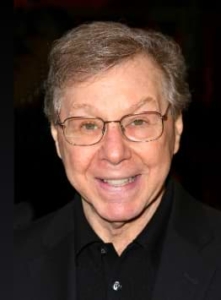
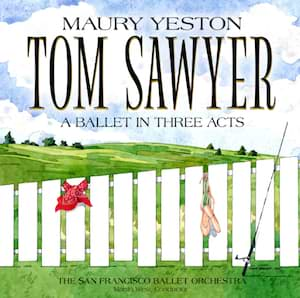
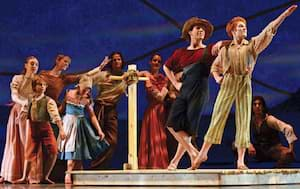 A NOTE FROM THE COMPOSER: Every project…a song, play, novel, film, poem, dance…begins as somebody’s dream…and if one is very lucky, hardworking, and patient, only sometimes can that dream become a reality. This is one of those sometimes. A number of years ago I asked myself as a composer, and musicologist, and lover of the Ballet, if I could identify the title of America’s most prominent three-act, full-length ballet – one specifically written by an American composer, based on an American literary masterpiece and premiered by an American choreographer and company. I could not answer my own question. In an instant, I thought “well, why don’t I write Tom Sawyer?” The music flew from my fingers almost as soon as I had the thought, and my intuition about the subject matter became increasingly validated as I noted that Twain’s masterpiece, like a good ballet, was episodic…Tom’s tricking his friends into whitewashing the fence – lost in the cave with Becky Thatcher – witnessing a murder with Huck in the graveyard – getting lost on the Mississippi and returning to secretly observe his own funeral! And I wanted the score to feel visual, and to reflect the great heritage of our American music, and to be accessible (like Twain’s novel) to people of all ages. Years later, most thrilling of all for me after the premiere of the work as choreographed by the brilliant William Whitener and presented by the Kansas Ballet to initiate the Kauffman Center in Kansas City, Alistaire Macauley in the New York Times confirmed what I had suspected at the start – “It’s quite likely that this is the first all-new, entirely American three-act ballet: it is based on an American literary classic, has an original score by an American composer, and was given its premiere by an American choreographer and company.” As if this were not enough, the ballet and music world took notice, and the invitation from the San Francisco Ballet Orchestra to record the entire three-act 85-minute work at George Lucas’ Skywalker Sound with a full complement of forty strings under the baton of Martin West was my genuine dream come true.From the moment I began to write Tom Sawyer as if a bolt of lightning illuminated an entire landscape for a split second, I saw in my mind the entire scenario and began to see the mythic and central role of the great Mississippi as the core and heart of the piece, the open landscape of the Great Plains, the “westering” nature of our American yearning for an endless frontier, and the profound connection whereby Twain preserved for all time not only the eternal youth of boyhood but also, metaphorically, an eternal portrait of the youth of America, the era of the America in which he lived.
And then I stopped. And I realized if I continued to compose, I would end up with a concert piece. But the Broadway dramatist within me knew instinctively that the event had to reside in the dance onstage, and not merely in the orchestra pit, and therefore I could only proceed in collaboration with a great choreographer. Though I never stopped developing and refining my own ideas, I kept waiting until fate and providence brought me and the remarkable William Whitener into the same room and from that point on we were off to the races.
What has fulfilled me most about the collaborative process has been the discoveries made along the way – particularly how the narrative elements (a murder, a trial, Tom’s exculpatory testimony) could be counterbalanced by the buoyancy of pure imagination. Is it summer evening, in Missouri? There would be Fireflies! Boys in a cemetery at midnight? They would imagine Ghosts and Goblins!
With the brilliance of William Whitener, our wonderful company of dancers, designers, orchestrators, Brad Dechter, Martin West, Adam Abeshouse, Tommy Krasker, and the generosity of Julia Kauffman, my dream of long ago miraculously has become actual, the great characters and creations of Mark Twain can now dance on stage as they have danced for over a century in our minds, and a complete recording of the heartfelt love I have poured into this musical storytelling can be preserved for all time.
A NOTE FROM THE COMPOSER: Every project…a song, play, novel, film, poem, dance…begins as somebody’s dream…and if one is very lucky, hardworking, and patient, only sometimes can that dream become a reality. This is one of those sometimes. A number of years ago I asked myself as a composer, and musicologist, and lover of the Ballet, if I could identify the title of America’s most prominent three-act, full-length ballet – one specifically written by an American composer, based on an American literary masterpiece and premiered by an American choreographer and company. I could not answer my own question. In an instant, I thought “well, why don’t I write Tom Sawyer?” The music flew from my fingers almost as soon as I had the thought, and my intuition about the subject matter became increasingly validated as I noted that Twain’s masterpiece, like a good ballet, was episodic…Tom’s tricking his friends into whitewashing the fence – lost in the cave with Becky Thatcher – witnessing a murder with Huck in the graveyard – getting lost on the Mississippi and returning to secretly observe his own funeral! And I wanted the score to feel visual, and to reflect the great heritage of our American music, and to be accessible (like Twain’s novel) to people of all ages. Years later, most thrilling of all for me after the premiere of the work as choreographed by the brilliant William Whitener and presented by the Kansas Ballet to initiate the Kauffman Center in Kansas City, Alistaire Macauley in the New York Times confirmed what I had suspected at the start – “It’s quite likely that this is the first all-new, entirely American three-act ballet: it is based on an American literary classic, has an original score by an American composer, and was given its premiere by an American choreographer and company.” As if this were not enough, the ballet and music world took notice, and the invitation from the San Francisco Ballet Orchestra to record the entire three-act 85-minute work at George Lucas’ Skywalker Sound with a full complement of forty strings under the baton of Martin West was my genuine dream come true.From the moment I began to write Tom Sawyer as if a bolt of lightning illuminated an entire landscape for a split second, I saw in my mind the entire scenario and began to see the mythic and central role of the great Mississippi as the core and heart of the piece, the open landscape of the Great Plains, the “westering” nature of our American yearning for an endless frontier, and the profound connection whereby Twain preserved for all time not only the eternal youth of boyhood but also, metaphorically, an eternal portrait of the youth of America, the era of the America in which he lived.
And then I stopped. And I realized if I continued to compose, I would end up with a concert piece. But the Broadway dramatist within me knew instinctively that the event had to reside in the dance onstage, and not merely in the orchestra pit, and therefore I could only proceed in collaboration with a great choreographer. Though I never stopped developing and refining my own ideas, I kept waiting until fate and providence brought me and the remarkable William Whitener into the same room and from that point on we were off to the races.
What has fulfilled me most about the collaborative process has been the discoveries made along the way – particularly how the narrative elements (a murder, a trial, Tom’s exculpatory testimony) could be counterbalanced by the buoyancy of pure imagination. Is it summer evening, in Missouri? There would be Fireflies! Boys in a cemetery at midnight? They would imagine Ghosts and Goblins!
With the brilliance of William Whitener, our wonderful company of dancers, designers, orchestrators, Brad Dechter, Martin West, Adam Abeshouse, Tommy Krasker, and the generosity of Julia Kauffman, my dream of long ago miraculously has become actual, the great characters and creations of Mark Twain can now dance on stage as they have danced for over a century in our minds, and a complete recording of the heartfelt love I have poured into this musical storytelling can be preserved for all time.
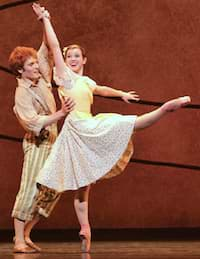 “It’s quite likely that this is the first all-new, entirely American three-act ballet: it is based on an American literary classic, has an original score by an American composer and was given its premiere by an American choreographer and company. The musical score is energetic, robust, warm, deliberately naïve (both ornery and innocent), in ways right for Twain. Mr. Yeston’s tuneful music with sonorities and harmonies that recall Copland, Barber and Prokofiev (Romeo and Juliet) ranges easily from comic to sinister, from Muff Potter’s drunkenness to a rich celebration of the Mississippi River.”
– Alastair Macaulay, Dance Critic for The New York Times
“Wow! William Whitener’s and Maury Yeston’s Tom Sawyer: A Ballet in Three Acts is an unequivocal delight – bold and varied and bursting with youthful energy, and featuring the widest array of choreography by Whitener and a musical score of great ingenuity by the Tony Award-winning Yeston.
Yeston’s musical style is deeply rooted in the classic Broadway tradition, with strikingly singable themes for each character, mood or emotion – soaring melodies for the love-couple, bouncy ditties for the comic moments of Act 1, sinister themes for the bad guys. It features several quite memorable tunes that will ensure this piece a long life on the stage. I especially liked the music for the Stone Angel sequence, and the Coplandesque opening of Act 3, whose expansive sound suggested the wide-open American West.
But there’s plenty more in the mix, from folk-like round dances to quirky Appalachian Spring hops and leaps, with suggestions of hyperactive, Tharp-like looseness. The “variations” in Act 2 featured an unfolding of the most appealing array of dance, accompanied by waltzes, marches, rags… at one point there was a pas de trois of dancing gravestones, in a beautiful melding of musical edginess and comically angular dance. A dulcet, invisible youth chorus lent a haunting Nutcracker moment to the proceedings.”
– Paul Horsely KC Independent
“Yeston’s score is a gorgeous piece of music saturated with Americana. Certain passages bring to mind Aaron Copland and other American composers we associate with folk-based symphonic music. He knows a thing or two about writing music to fit a dramatic narrative. He won Tony Awards for his Broadway shows, Nine and Titanic. For Tom Sawyer, he leads us along with swelling highs and nuanced lows, mixing drama with lyricism in a score that flows sensuously (and) captures the rhythms of the mighty Mississippi — Twain’s version of the river that has galvanized the imaginations of generations of writers and musicians.”
– Robert Trussle, Kansas City Star
“Set to an original score by Tony-winning composer Maury Yeston, the emotionally affecting music is full of alluring melodies, dancey tunes, and bright energy that fuels the proceedings.”
– Lisa Jo Sagolla, Kansas City Star
“The music by composer Maury Yeston is Americana to the point where you almost expect George Gershwin to be nodding along in approval.”
– Angie Fiedler Sutton, Kansas City Infozine
“It’s quite likely that this is the first all-new, entirely American three-act ballet: it is based on an American literary classic, has an original score by an American composer and was given its premiere by an American choreographer and company. The musical score is energetic, robust, warm, deliberately naïve (both ornery and innocent), in ways right for Twain. Mr. Yeston’s tuneful music with sonorities and harmonies that recall Copland, Barber and Prokofiev (Romeo and Juliet) ranges easily from comic to sinister, from Muff Potter’s drunkenness to a rich celebration of the Mississippi River.”
– Alastair Macaulay, Dance Critic for The New York Times
“Wow! William Whitener’s and Maury Yeston’s Tom Sawyer: A Ballet in Three Acts is an unequivocal delight – bold and varied and bursting with youthful energy, and featuring the widest array of choreography by Whitener and a musical score of great ingenuity by the Tony Award-winning Yeston.
Yeston’s musical style is deeply rooted in the classic Broadway tradition, with strikingly singable themes for each character, mood or emotion – soaring melodies for the love-couple, bouncy ditties for the comic moments of Act 1, sinister themes for the bad guys. It features several quite memorable tunes that will ensure this piece a long life on the stage. I especially liked the music for the Stone Angel sequence, and the Coplandesque opening of Act 3, whose expansive sound suggested the wide-open American West.
But there’s plenty more in the mix, from folk-like round dances to quirky Appalachian Spring hops and leaps, with suggestions of hyperactive, Tharp-like looseness. The “variations” in Act 2 featured an unfolding of the most appealing array of dance, accompanied by waltzes, marches, rags… at one point there was a pas de trois of dancing gravestones, in a beautiful melding of musical edginess and comically angular dance. A dulcet, invisible youth chorus lent a haunting Nutcracker moment to the proceedings.”
– Paul Horsely KC Independent
“Yeston’s score is a gorgeous piece of music saturated with Americana. Certain passages bring to mind Aaron Copland and other American composers we associate with folk-based symphonic music. He knows a thing or two about writing music to fit a dramatic narrative. He won Tony Awards for his Broadway shows, Nine and Titanic. For Tom Sawyer, he leads us along with swelling highs and nuanced lows, mixing drama with lyricism in a score that flows sensuously (and) captures the rhythms of the mighty Mississippi — Twain’s version of the river that has galvanized the imaginations of generations of writers and musicians.”
– Robert Trussle, Kansas City Star
“Set to an original score by Tony-winning composer Maury Yeston, the emotionally affecting music is full of alluring melodies, dancey tunes, and bright energy that fuels the proceedings.”
– Lisa Jo Sagolla, Kansas City Star
“The music by composer Maury Yeston is Americana to the point where you almost expect George Gershwin to be nodding along in approval.”
– Angie Fiedler Sutton, Kansas City Infozine
Act Two
Act Three
ACT ONE
1. Overturette; The Fence2. Way Down South
3. Tom and the Town
4. Lazy Day
5. Off to School
6. In the Classroom
7. Tom and Becky
8. Huck Finn
9. Looking West
10. Games and Competitions
11. To the Mississippi
12. Pirates
13. Storm
14. Funeral and Salvation / Coda
ACT TWO
15. Muff Potter—Duet for Man and Flask16. A Conspiracy
17. Dance of the Fireflies
18. March of the Goblins
19. Ghosts
20. The Sprite’s Circus
21. The Stone Angel
22. A Murder
23. A Death
24. Requiem for Doc
ACT THREE
25. Overture to Act 3; Looking West
27. The Prosecution
28. Tom’s Testimony
29. Praise and Thanks
30. Pinwheels
31. The Picnic
32. Lost in the Cave
33. Dance of True Love
34. Pinwheels (reprise)
35. Saved
36. To the Mississippi (reprise)
37. The Great Mississippi
<
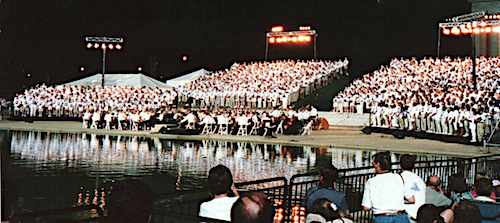
“An American Cantata” is a composition by Maury Yeston for 2,000 voices and the National Symphony Orchestra conducted by Leonard Slatkin. It was commissioned by the Kennedy Center for performance on the steps of the Lincoln Memorial as part of the Millennium Celebration in the Spring of the year 2000.
Composed and orchestrated by Yeston, the piece is a three-movement work that celebrates the achievement of the idea of individual liberty and equality, along with our inherent and universal entitlement to it, and the sanctity of each human life, as our civilization’s single greatest intellectual accomplishment of the past thousand years.
Sung by a Mixed Chorus, Boys Choir, and Gospel Choir; texts include excerpts from the Magna Carta, the writings of Thomas Jefferson, Martin Luther King Jr.’s final Memphis speech (“I have been to the mountaintop”), and original lyrics by Yeston.
COMPOSER’S NOTE: In the photo above there are about 60 in the band, 200 in the Boys and Girls choir down left, and 200 in the Gospel choir down right. Then behind the band, 800 on the left and 800 on the right … inspired by the antiphonal choirs at St. Marco Venice (Gabrielli etc,). There were about 20,000 in the audience, arrayed down towards the Washington monument. When they commissioned me to write it for 2000 voices I asked if they would want 3000 if it were the year 3000. Of course, they said yes! The use of 2000 voices was a one-time event. The piece may be performed by far fewer voices such as 90 (30+30+15+15). The term “Boys Choir” denotes the desired sound. This may absolutely be a Children’s Choir composed of boys and girls.
CELLO CONCERTO
COMPOSITIONS FOR PIANO SOLO
COMPOSITIONS FOR SOPRANO AND SOLO PIANO
(With Piano or Chamber Orchestra accompaniments)
